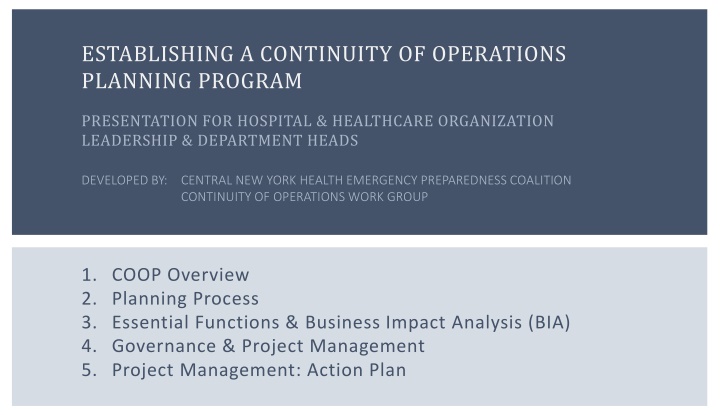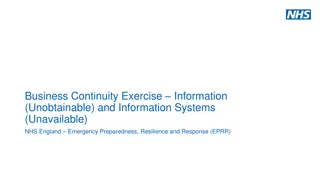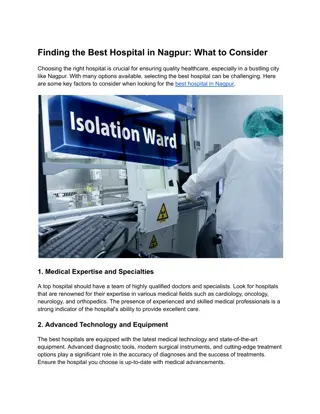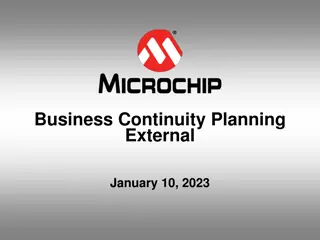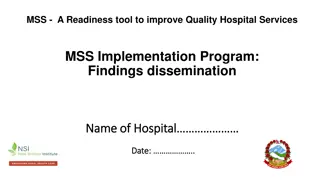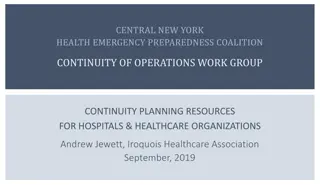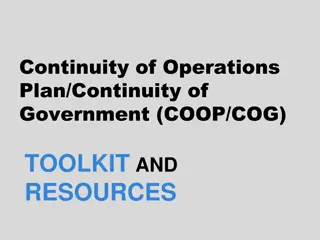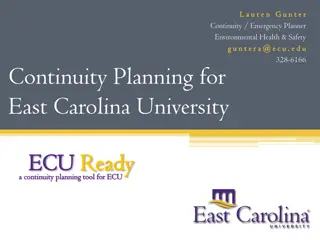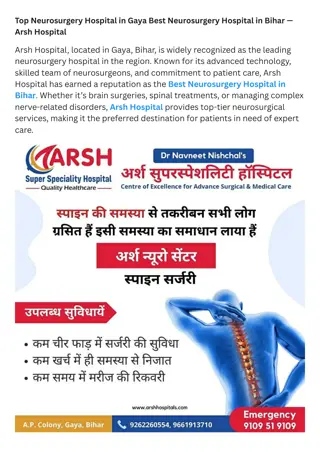Hospital & Healthcare Continuity of Operations Planning Program Presentation
This presentation developed by the Central New York Health Emergency Preparedness Coalition outlines the importance of Continuity of Operations Planning (COOP) for hospital and healthcare organizations. It covers the planning process, essential functions, business impact analysis, governance, project management, and action plan. The content emphasizes the need for COOP to ensure patient care, facility services, and business operations are maintained during disruptions. Executive support, project leadership, and clear planning processes are highlighted as prerequisites for successful COOP implementation.
Download Presentation

Please find below an Image/Link to download the presentation.
The content on the website is provided AS IS for your information and personal use only. It may not be sold, licensed, or shared on other websites without obtaining consent from the author.If you encounter any issues during the download, it is possible that the publisher has removed the file from their server.
You are allowed to download the files provided on this website for personal or commercial use, subject to the condition that they are used lawfully. All files are the property of their respective owners.
The content on the website is provided AS IS for your information and personal use only. It may not be sold, licensed, or shared on other websites without obtaining consent from the author.
E N D
Presentation Transcript
ESTABLISHING A CONTINUITY OF OPERATIONS PLANNING PROGRAM PRESENTATION FOR HOSPITAL & HEALTHCARE ORGANIZATION LEADERSHIP & DEPARTMENT HEADS DEVELOPED BY: CENTRAL NEW YORK HEALTH EMERGENCY PREPAREDNESS COALITION CONTINUITY OF OPERATIONS WORK GROUP 1. COOP Overview 2. Planning Process 3. Essential Functions & Business Impact Analysis (BIA) 4. Governance & Project Management 5. Project Management: Action Plan
ESTABLISHING A CONTINUITY OF OPERATIONS PLANNING PROGRAM PRESENTATION FOR HOSPITAL & HEALTHCARE ORGANIZATION LEADERSHIP & DEPARTMENT HEADS 1. COOP OVERVIEW A. What is Continuity of Operations Planning? B. Why Establish a Continuity of Operations Plan? C. What is Needed?
WHAT IS CONTINUITY OF OPERATIONS PLANNING? Process to identify Essential Functions (EF) and develop action plans and strategies to maintain patient care, facility services and business operations; Continuity of Operations plans identify: Risks and measure impact to operations; Essential functions and impacts of interruptions; Supporting activities needed to maintain functions; Recovery objectives and strategies.
WHY ESTABLISH A COOP PLAN? Ensures critical planning gaps, and budgetary and management challenges are identified and addressed; Protects patient safety; ensures access to care; Recognizes and protects the business and investments of the hospital in order to: Maintain market share in highly competitive environment; Maintain revenue and profitability by continuing to provide and bill for services in a timely manner; Meets regulatory and accreditation standards.
WHAT IS NEEDED? Executive support to ensure organizational awareness and participation; Project leadership by Steering Committee; Announcement summarizing objectives, planning roles and participant expectations; Simple, clearly defined planning processes: Project planning tools to define milestones and resources; Data gathering and documentation tools and templates.
ESTABLISHING A CONTINUITY OF OPERATIONS PLANNING PROGRAM PRESENTATION FOR HOSPITAL & HEALTHCARE ORGANIZATION LEADERSHIP & DEPARTMENT HEADS 1. PLANNING PROCESS A. Identify Mission Essential Functions B. Data Analysis: Risk Analysis & Business Impact Analysis (BIA) C. Determine Continuity Plan Priorities D. Develop Additional Elements of Continuity Plan
COOP PLANNING OBJECTIVES Ensure continued performance of essential functions; Reduce loss of life/minimize damage; Ensure succession to office of key leadership; Reduce/mitigate disruptions to operations; Protect essential assets; Achieve timely recovery/reconstitution; Maintain TT&E program for validation and improvement.
IDENTIFY ESSENTIAL FUNCTIONS Essential Functions (EF): Clinical and business activities that cannot be deferred and must be performed continuously or resumed quickly; Key planning factors necessary to determine care delivery, staffing, communications, essential records, facilities, etc. Distinguish between essential and important (non-essential) functions: Identify activities that can and cannot be deferred; Deferring non-essential activities free up resources that can be redirected to those that cannot be deferred.
DATA ANALYSIS Review HVA to identify threats and risks to operations and infrastructure; Business Impact Analysis (BIA) results in prioritization of EFs: Develop work plan for conducting the BIA; Review operations within each department; Identify all departmental EFs and their Essential Supporting Activities (ESA); Analyze data and rank according to priority.
DETERMINE CONTINUITY PLAN PRIORITIES Focus on rapid resumption of the health care organizations EFs and their Essential Supporting Activities (ESA); Once primary EFs are identified, it is important to be able to accomplish the critical activities needed to support their execution.
DEVELOP ADDITIONAL ELEMENTS OF PLAN Orders of Succession Delegation of Authority Continuity of Facilities Continuity Communications Vital Records Management Plan for Human Resources Plan for Devolution of Control Plan for Restoration/Reconstitution Maintaining Continuity Readiness
ESTABLISHING A CONTINUITY OF OPERATIONS PLANNING PROGRAM PRESENTATION FOR HOSPITAL & HEALTHCARE ORGANIZATION LEADERSHIP & DEPARTMENT HEADS 3. ESSENTIAL FUNCTIONS & BUSINESS IMPACT ANALYSIS A. Identify Essential Functions (EF) B. Conduct Threat & Risk Analysis C. Conduct Business Impact Analysis (BIA) D. Determine Continuity Priorities
IDENTIFY ESSENTIAL FUNCTIONS Primary essential functions (EF) of the health care organization: Activities that enable an organization to provide vital clinical and business services; Cannot be deferred; Must be performed continuously or resumed quickly; Key planning factors to determine appropriate care delivery, staffing, communications, etc. essential records, facilities, etc.
CONDUCT THREAT & RISK ANALYSIS Review HVA to identify threats and risks that pose a hazard to the operations of the hospital and IT infrastructure.
CONDUCT BUSINESS IMPACT ANALYSIS (BIA) BIA data informs strategic and financial decisions. Systematically measures impact if functions and processes cannot be performed. Identifies, prioritizes and documents essential functions and relative importance of departmental processes and resources Business Processes Equipment or Resources Staffing Positions Data & Records Technology & Equipment Departmental Dependencies Financial Impact
DETERMINE CONTINUITY PRIORITIES Once EFs are identified, must be able to accomplish the critical activities needed to support their execution; Focus on rapid resumption of EFs and their Essential Supporting Activities (ESA); Use data to make decisions to reduce risks that will have the greatest adverse impact.
ESTABLISHING A CONTINUITY OF OPERATIONS PLANNING PROGRAM PRESENTATION FOR HOSPITAL & HEALTHCARE ORGANIZATION LEADERSHIP & DEPARTMENT HEADS 4. GOVERNANCE & PROJECT MANAGEMENT A. Continuity Steering Committee B. Continuity Planning Committee & Program Coordinator C. Project Management Key Planning Committee Activities
CONTINUITY STEERING COMMITTEE Members include executive sponsor and key leaders: COO, CNO, CMO, CIO; VP Facilities, VP HR, EM, etc. Responsible for determining objectives and priorities, recovery solutions, risk mitigation strategies etc.; Appoint a Continuity Program Coordinator and Planning Committee to execute project activities; Arrange for an announcement summarizing objectives, planning roles and participant expectations.
CONTINUITY PLANNING COMMITTEE & PROGRAM COORDINATOR Led by Continuity Program Coordinator; Members include key operational and department leaders: Materials Management, Support Services, Finance, Risk/Compliance, IT, Security, ED, HR, Nursing etc. Responsible for executing projects and activities: Identify project participants; Provide education on planning objectives, data gathering and tools; Oversee and ensure completion of data gathering and other tasks assigned to project participants.
PROJECT MANAGEMENT Key Planning Committee Activities: Identify organization s primary essential functions (EF); Develop a work plan for conducting the BIA; Collect list of depts and associated cost centers from finance; Educate department leaders on objectives and how to complete business continuity profile; Review with each department their EFs that support the hospital s primary EFs, and identify all essential supporting activities needed for their execution; Oversee completion of business continuity profiles.
ESTABLISHING A CONTINUITY OF OPERATIONS PLANNING PROGRAM PRESENTATION FOR HOSPITAL & HEALTHCARE ORGANIZATION LEADERSHIP & DEPARTMENT HEADS 5. PROJECT MANAGEMENT: ACTION PLAN A. Identify Essential Functions (EF) B. Conduct Business Impact Analysis (BIA) C. Review Data & Capabilities D. Develop Strategies and Integrated Plan Framework
CONTINUITY STEERING COMMITTEE Identify the health care organization s Essential Functions (EF); Conduct Business Impact Analysis (BIA): Develop a work plan for conducting the BIA; Review with each department their EFs that support the organization s primary EFs, and identify all Essential Supporting Activities (ESAs) needed for their execution; Complete business continuity profiles.
CONTINUITY STEERING COMMITTEE Review Data & Capabilities: Review BIA and HVA findings; Use data to make decisions to reduce risks having the greatest adverse impact; Examine 96-hour capabilities and strategies for ensuring continuity; Meet with facilities, supply chain and IT to understand capabilities and integration points.
CONTINUITY STEERING COMMITTEE Develop Strategies & Integrated Continuity Plan: Determine strategies and requirements for continuity of operations, alternate locations and mobile capabilities; Solicit cost estimates for selected alternate site, mobile and disaster recovery strategies; Present recommended strategies and pricing options for approval; Develop approach to align/integrate emergency operations, IT disaster recovery and COOP plans; Develop additional elements of continuity plan.
